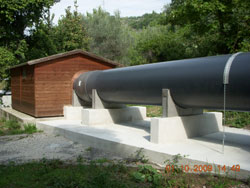|
 A revolution for freight transports
A revolution for freight transportsPipežnet is an innovative freight transport system. It is constituted by a net of special pipes and other devices which will allow an high speed and low energy freight transport. Each freight package will be carried into original capsules; capsules dimensions and characteristics will travel into the pipes at high speed and with low friction. Capsules movement will be obtained by linear synchronous motors; movement support will be obtained by original sublimation and magnetic levitation systems. The net will allow to connect every points where a freight shipment or receiving is needed. So, Pipežnet may allow to connect residential houses, commercial centres, every selling and/or distribution points, factories, offices, "just in time" centralized stores, pharmacies, hospitals, etc. The aforesaid devices will allow to obtain a new transport infrastructure which will cover an important freight partition; pipežnet will interconnect itself to internet in order to improve and increase its performances (E-Commerce). Pipežnet characteristics will be: high speeds (up to 1500 km/h), low enviromental impact (air, noise, etc.), flexibility. The system will start with B2B (business to business) connections among industrial points; subsequently, pipežnet will arrive gradually to B2C (business to consumer) or C2C (consumer to consumer) connections. |
